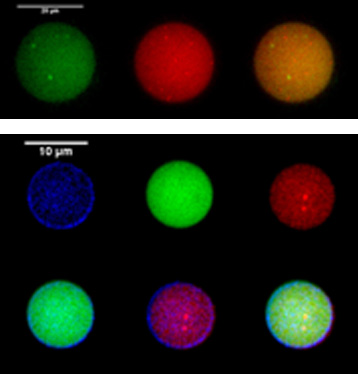A research team at the Organic Polymer Chemistry Laboratory (CNRS/ Bordeaux 1 University/ Polytechnic Institute of Bordeaux) has succeeded in encapsulating nanovesicles inside slightly larger vesicles, paving the way for new options in terms of compartmentalized reactors, multiple encapsulation and vector administration through new delivery channels.
 Top, encapsulation of two types of internal polymersome populations, one in green and the other in red. Bottom, encapsulation in all the possible compartments: external membrane (blue), cavity of the external polymersome (green), internal polymersomes (red). © Organic Polymer Chemistry Laboratory (CNRS/ Bordeaux 1 University/ Polytechnic Institute of Bordeaux)
Top, encapsulation of two types of internal polymersome populations, one in green and the other in red. Bottom, encapsulation in all the possible compartments: external membrane (blue), cavity of the external polymersome (green), internal polymersomes (red). © Organic Polymer Chemistry Laboratory (CNRS/ Bordeaux 1 University/ Polytechnic Institute of Bordeaux)
So far, liposomes or lipid vesicles are the primary nanovectors to have been studied for drug delivery. Polymersomes, which are polymer-based analogs of liposomes, have high stability and impermeability and can be easily modulated and functionalized. Over a decade, the research team has been working on the development of ‘intelligent’ polymersomes using polypeptides whose structures and properties are similar to those of viruses.
The research team is further extending this biological imitation and inspiration by encapsulating polymersomes inside each other. This compartmentalization or ‘Russian doll’ structure imitates a cell structure. The team used a special emulsion/centrifugation technique to form the encapsulated polymersomes in a controlled manner. The rapid and simple method is very efficient and needs fewer reagents. The team then utilized fluorescent markers for imaging in order to show the creation of structures that have polymersomes encapsulated inside each other. Controlling this compartmentalization paves the way to encapsulate numerous compounds or vesicles inside a single vector, which is helpful in treating cancer effectively.
The research team has also demonstrated the possibility of encapsulating various reagents in different compartments of polymersomes by encapsulating three fluorescent molecules in the three different compartments of the polymersomes. It has also showed the possibility of activating various cascade reactions in the polymersomes. Besides offering enhanced protection to the encapsulated active ingredients, this novel packaging method enables an accurate modulation of the vesicles’ permeability properties. The team’s next step is to utilize this method in attoliter volumes to activate controlled chemical reactions in a closed environment.